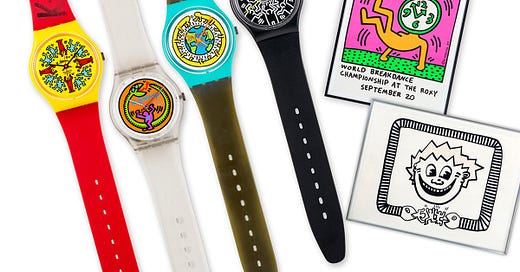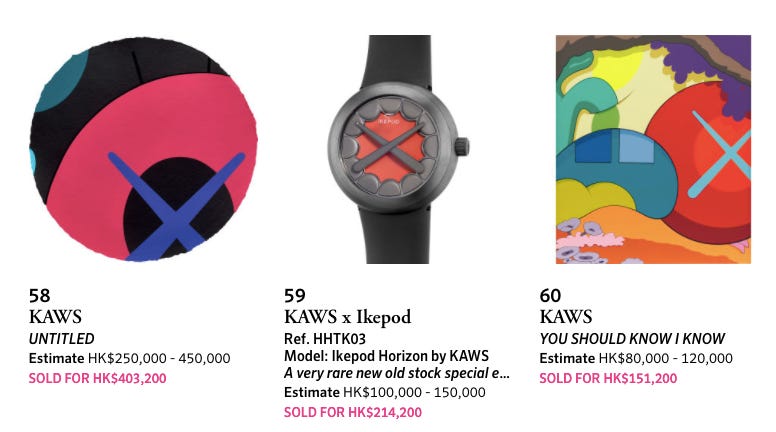The intersection of art and watches has always fascinated me. Phillips’ Intersect Auction — an online sale featuring contemporary art, jewelry, and watches — earlier this year got me thinking about it more explicitly. Sure, there have been ambitious crossover events before, but this one hit a nerve.
For some reason, it struck me as both exciting and disheartening to see some of the watches I spend too much time thinking about thrown together with pop art from Murakami, jewels from Chanel, bags from Hérmes. I love when watches cross over into distinctly non-watch arenas, but it also kind of felt like one long Drake song, name-dropping brands and things just to have.1
The piece of the sale that most attracted me, then, was the one that perhaps best captured these overall feelings towards it: Great Criticism Series: Swatch, by Chinese artist Wang Guang Yi. To borrow from the catalog entry:
The logo of the iconic watch brand is firmly anchored in the foreground, juxtaposing communist propaganda with a logo representing Western commercial propaganda. Rendered deliberately kitsch, “Swatch” explores the tension between the potent legacy of Communist propaganda and the powerful allure of Western advertising, blurring the lines between the visual languages of the two.

It’s one of dozens of works from the Great Criticism series, all derivatives of this formula, mashing up famous western brands with idealized figures of Mao’s revolution. Hundreds of little numbers are also scattered on the canvas — reminiscent of bar codes or serial numbers — references to the standardization systems of both consumerism and the Cultural Revolution.
It’s pretty pensive stuff, obviously much more high-brow than an e-magazine such as this might fully comprehend.
But, it strikes at a larger issue we talked about a few weeks ago, when The New York Times wrote the article Here’s how bored, rich people are spending their money. Focusing on inflating prices of cars, watches, and everything else, it wrote: “Rich people who shopped too much used to be called collectors. Now they — and those belonging merely to the aspirational class — are all investors.”
But what’s the fun in investing? Investing is the 401k-index-fund-oh-wait-are-taxes-already-due-next-week-and-did-I-forget-to-file-them stuff. Nowadays, it feels like too many people are collecting to invest — either to acquire actual or social (“I heard it in a Drake song”) capital.
Of course, the artist’s point in the Great Criticism series is that, while communism and capitalism might be diametrically opposed in ideology, both use (sometimes strikingly similar) propaganda to get people to buy into a certain belief system.2 Something something … we’re all just sheep.
Done right though, collecting is a way to fight becoming just another serial number scattered across the canvas. It’s a way to be different, an individual. It shouldn’t be another way of assimilating, of becoming yet another number or a means to acquire social capital.
I’m reminded of something Michael Williams said in our interview last year:
“I struggle with the person who has all the grail items: a Porsche 911, a Defender, a Daytona, a Leica. All those things in one package — all that stuff is cool, but my goal in life is not to have those things.”
Q: It’s putting it all together that’s the problem with you?Yea, exactly. It's like driving a Tesla, having a Lange, working in venture capital and living in the Bay Area. It's so predictable. It's like you saw the ads and just bought the whole kit. I love the weird, original, 'what do you own that's so weird that people don't get?' That to me is original, and I want to know what's wrong with them that they like it.”
Maybe that was my problem scrolling through the Phillips Intersect Auction: it all felt so predictable, so formulaic. Like someone saw the ads and bought the whole kit (or rather, they could buy it at this very auction).
Real “collecting” isn’t formulaic or predictable. It’s not standardized bar codes and serial numbers scattered on a canvas. It’s fighting these very ideas by being an individual, just like Wang Guang Yi’s Great Criticism.
👉 Rescapement is an independent weekly newsletter about watches. Subscribe now to get weekly deep dives and takes like this in your inbox:
Art and watches: How Keith Haring informed 2021’s best art watches
Anyway, the intersection of art and watches is the topic of my latest piece over on Highsnobiety. At their best, the two impact each other in a positive way, breaking down barriers and making traditionally exclusive spaces more accessible. While in general, I don’t subscribe to the “watches are art” cliche (of course, there are exceptions) I do think the two forms have a lot in common in terms of their impact both on society and the individual:
In 1986, artist Keith Haring opened the Pop Shop in SoHo, New York. It was an extension of his idea that art should be accessible to everyone, rather than locked away in exclusive museums or galleries.
“Art is nothing if you don’t reach every segment of the people,” said Haring, addressing the commercialization of his work.
Among the first products sold at the Pop Shop was a collection of four Swatch watches, which Haring designed himself. In a similar vein to Haring's art, Swatch was conceived by the Swiss watch industry in the 1980s as a way to make watches accessible, affordable, and fun. This came as the rise of battery-powered (quartz) watches threatened to render traditional high-end, Swiss-made mechanical timepieces obsolete.
When Swatch and Haring teamed up, it was the first time watches and art became cool. Here was the famous pop artist of his generation mashing up the trendiest watch of the decade.
Read the full story on Highsnobiety.
The new Mini CasioOak is totally badass and available for $99
Not often do I see a watch in person and immediately figure out how to buy one. Usually, I let it marinate: is this just me being tantalized by another temptress, an infatuation that’ll surely fade with time?
And when so many watches exceed prices that any reasonable person should pay for an outdated anachronism, I usually let the feeling fade.
But the new G-Shock GMAS2100 series (or “Mini CasiOak”) is different.
I first spotted these at a local G-Shock retailer, ashamed to admit that I completely missed the early 2021 release of these very cool watches because I was paying attention to some other (mostly less cool) ones coming out of some virtual trade show.
Better late than never, as they say.
I slipped one on my wrist and immediately was smitten. The thinnest G-Shock ever! All in, the Mini CasiOak measures 46.2 x 42.9 x 11.2 millimeters, one of the most wearable G-Shocks around.
But the best part is when you slip it off and glance at the price tag: $99.
Read the full story.
Turn back the clock. We received a number of positive and/or thoughtful responses to our last couple articles, Rolex and the return of ‘sports elegance’, and our special Mother’s Day edition, so thanks to all who engaged. Next week, I’m going to publish a sort of review of the Tudor Black Bay Fifty-Eight Silver 925, comparing it to a “Lollipop” Tudor Submariner. I’ve long struggled with how Rescapement can fit into the broader watch review landscape. That said, there are times when — hopefully — we have a unique perspective to offer. In this case, I’m “reviewing” and comparing two of my personal watches. But I’m truly not writing the piece to talk my own book (and I hope it doesn’t come across that way), but because there seems to be broader interest in the Silver Black Bay Fifty-Eight.
Crash into me. Nick Foulkes and George Bamford talking about the Cartier Crash is a totally fun listen:
Rescapement is an independent weekly newsletter about watches. Subscribe now to get it delivered to your inbox every Sunday. Follow us on IG too.
Literally, you could’ve put together a shopping list from ‘Goin Bad’ — put a Richard on the card; got a lot of Murakami in the hallways; got 80 racks in my Amiris — and gotten everything off your list at this sale.
Please don’t hit me with the “how could you compare capitalism and communism!?!” emails. I didn’t compare them, the artist did. I’m just the vessel.









